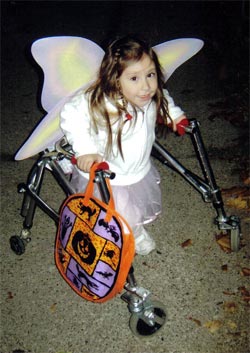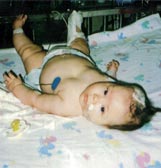Neurosurgeon: Bruce A. Kaufman, MD, FAANS, Children’s Hospital of Wisconsin, Milwaukee, Wis.
Patient: Jordyn Landowski, age 5, Spina Bifida, Hydrocephalus, Chiari Type 2 Malformation
Jordyn Landowski was diagnosed with spina bifida at 17-weeks gestation. Her mother Sandi was told to terminate the pregnancy at the clinic she was attending. Today, Jordyn is a sweet little girl with a remarkably upbeat attitude, despite physical challenges including undergoing 12 surgeries to date.
Spina bifida occurs during the third and fourth weeks of pregnancy when a portion of the fetal spinal cord fails to properly close. As a result, the child is born with a part of the spinal cord exposed on the back.
About 80 to 90 percent of children with spina bifida develop hydrocephalus. Hydrocephalus is a condition in which excess cerebrospinal fluid (CSF) builds up within the ventricles (fluid-containing cavities) of the brain and may increase pressure within the head. Most children will require a ventricular shunt to control the build-up of fluid.

Spina bifida occurs during the third and fourth weeks of pregnancy when a portion of the fetal spinal cord fails to properly close. As a result, the child is born with a part of the spinal cord exposed on the back.
Chiari type 2 malformation is characterized by downward displacement of the medulla, fourth ventricle, and cerebellum into the cervical spinal canal, as well as elongation of the pons and fourth ventricle. This type occurs almost exclusively in patients with myelomeningocele, a type of spina bifida.

In the Words of Jordyn’s Mother
Having been told at 17-weeks gestation that my daughter had spina bifida, I knew that her physical condition would present some challenges and, of course, I was frightened. At 20-hours old, Jordyn had her back closed; at 6-days old, she had a ventricular shunt inserted. At 3-months old, she developed life-threatening symptoms that no one could diagnose. She would stop breathing, turn blue, her entire chest would cave in when she breathed, and she was aspirating her formula.
We were told she had everything from the flu to acid reflux. We were given numerous medications to “cure” her, but nothing worked. We were told her shunt was malfunctioning, so that was revised. That still did not alleviate her horrible symptoms.
Although Chiari type 2 malformation is fairly rare, Jordyn had enough signs for her neurosurgeon, Bruce Kaufman, MD, FAANS, to test her. Once the diagnosis was confirmed, Dr. Kaufman scheduled her for decompression surgery. Dr. Kaufmann didn’t give up on our daughter’s life. He fought side-by-side with us, he listened to us, but most importantly, he paid close attention to the body of our precious little girl.
Jordyn, who will celebrate her 6th birthday on July 7, will be entering the first grade in September. She enjoys school and her friends very much. Everyone at school knows Jordyn because she’s always so positive and happy and runs through the halls with her walker. Jordyn’s passions include the water, crafts, playing in her sandbox and going fishing at her grandparents’ house. She tells everyone how she’s “never caught nothin’ but seaweed.”
Jordyn sees Dr. Kaufman once a year for an annual check-up. The truth of the matter is that if it weren’t for Dr. Kaufman, my beautiful little girl would not be here. I did my part protecting her to get her into this world, and Dr. Kaufman is helping to make sure she stays. Jordyn and Dr. Kaufman make a great team!
Note from AANS
The AANS does not endorse any treatments, procedures, products or physicians referenced in these patient fact sheets. This information is provided as an educational service and is not intended to serve as medical advice. Anyone seeking specific neurosurgical advice or assistance should consult his or her neurosurgeon, or locate one in your area through the AANS’ Find a Board-certified Neurosurgeon online tool.
